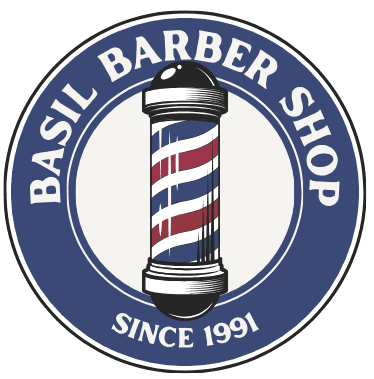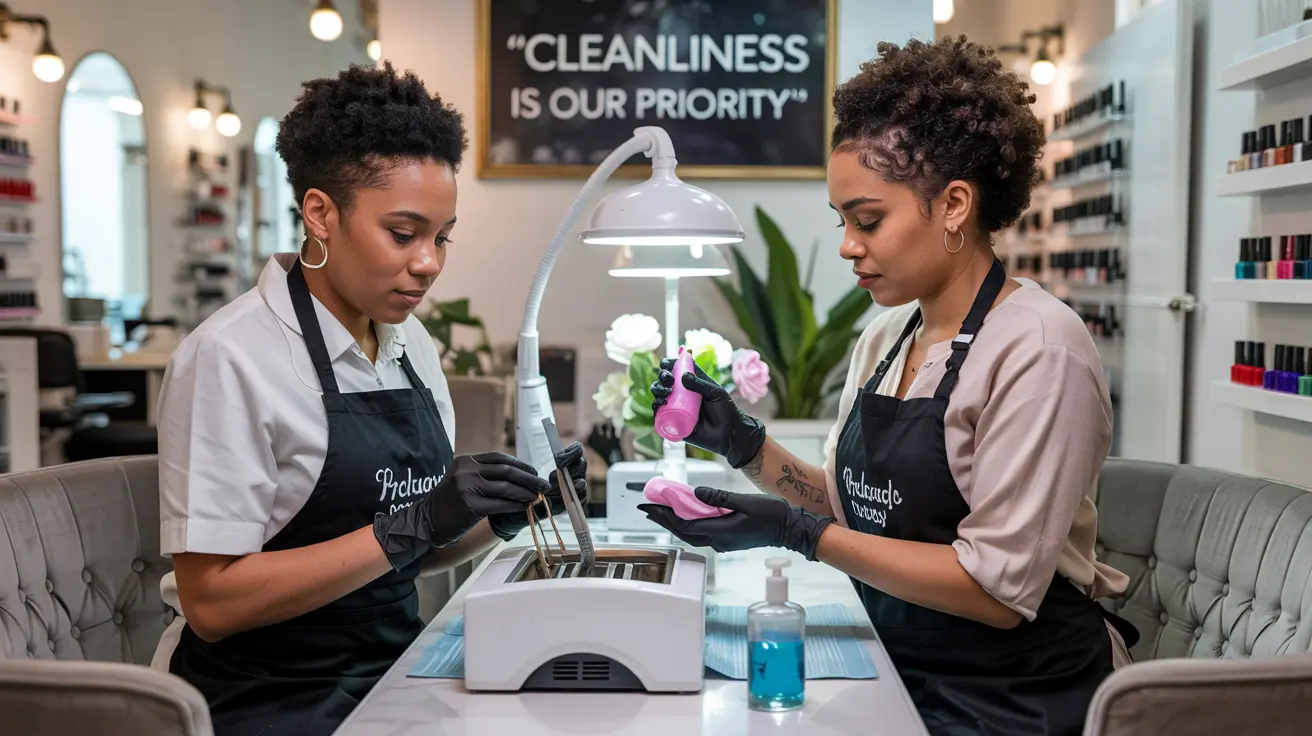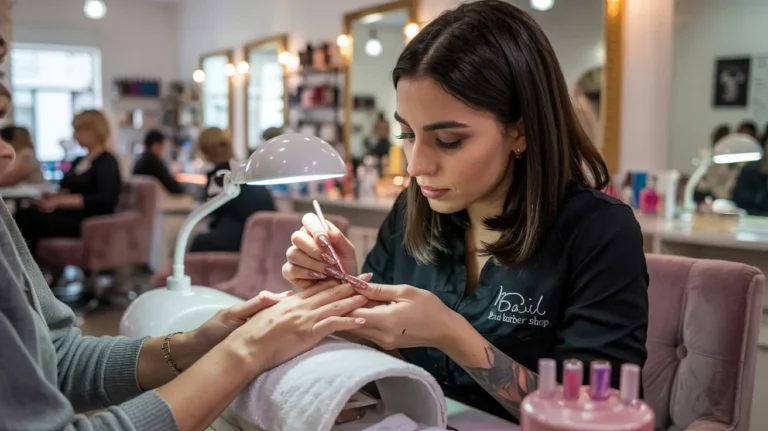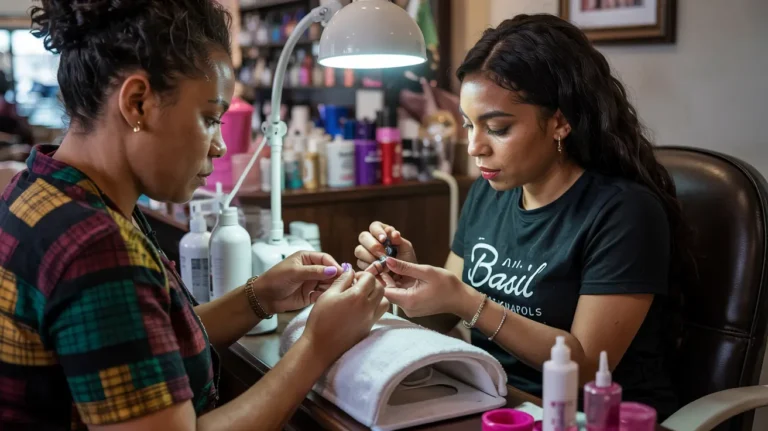Indianapolis Nail Salon Safety Standards: What Every Client Should Know
Did you know that nearly 75% of nail salon clients never ask about sanitation procedures before getting services? I was shocked when I first learned this statistic during my nail technician training years ago. In a world where we’re increasingly conscious about health and hygiene, it’s surprising how many of us trust our hands and feet to salons without considering safety standards.
I’ll never forget my first pedicure experience when I was in college. The salon looked fancy from the outside, but I noticed the technician using the same tools between clients with just a quick wipe-down. Yikes! That experience taught me how crucial proper safety standards really are, especially here in Indianapolis where regulations can vary between establishments.
When it comes to nail salon safety, what you don’t know absolutely can hurt you. That’s why understanding Indianapolis nail salon safety standards isn’t just about peace of mind—it’s about protecting your health while still enjoying those well-deserved beauty treatments. At places like Basil Beauty and Barber Shop on West 38th Street, safety isn’t just followed—it’s celebrated as part of providing exceptional service.
Understanding Indianapolis Nail Salon Regulations
Let me tell you, navigating Indianapolis nail salon regulations was no walk in the park when I first entered the industry! The Marion County Public Health Department has some pretty specific requirements that every legitimate salon must follow. These regulations aren’t just bureaucratic red tape—they’re there to protect you, me, and everyone who sits in those comfy pedicure chairs.
All Indianapolis nail salons must have current business licenses and salon-specific permits displayed where clients can easily see them. I learned this lesson the hard way when I consulted for a new salon that got fined during their first week because their paperwork was tucked away in a folder instead of on display! Each nail technician should also have their state cosmetology or manicurist license visible, proving they’ve completed the required training hours and passed state examinations.
The health department conducts regular inspections, typically unannounced, to ensure compliance with safety standards. Salons should maintain inspection records for at least two years. I remember nearly having a heart attack during my first surprise inspection, even though we were following all the rules! It’s totally normal to ask about a salon’s most recent inspection results—any reputable place like Basil Beauty and Barber Shop will be proud to share this information.
Want to verify if a salon is playing by the rules? You can! The Indiana Professional Licensing Agency maintains an online database where you can check if a salon and its technicians hold valid licenses. I make a habit of checking this before trying new places, and I’ve definitely walked out of salons that couldn’t produce proper documentation when asked. Your health is worth that extra bit of research!
Indianapolis regulations also mandate specific protocols for handling certain tools and equipment. For instance, certain implements must be sanitized using particular disinfectants or an autoclave. Other items, like emery boards and buffers, should be single-use or assigned to individual clients. Trust me, learning all these regulations was overwhelming at first, but now I understand how essential they are for preventing cross-contamination.
Essential Sanitation Practices in Quality Nail Salons
I’ve been in enough nail salons to know that cleanliness isn’t just about appearances—it’s about detailed sanitation practices that many clients never see happening behind the scenes. The best salons, like Basil Beauty and Barber Shop, have comprehensive sanitation protocols that go way beyond the basics.
Tool sterilization is absolutely non-negotiable in a quality salon. Metal implements should be cleaned, disinfected in hospital-grade solution, and sterilized in an autoclave between each client. I remember visiting a friend’s salon where they were just spraying tools with disinfectant and calling it a day—I nearly had a conniption! Proper sterilization means a three-step process: cleanse, disinfect, and sterilize. Anything less is cutting corners with your health.
One time, I developed a nasty skin reaction after getting a pedicure at a salon that reused pumice stones between clients. Never again! Quality salons use disposable items for anything that can’t be thoroughly sterilized—that includes buffers, nail files, toe separators, and pumice stones. These items should be new for each client or designated as “single-client use” tools that are labeled and stored for your return visits only.
The pedicure basin cleaning procedure is something I’m super particular about after seeing how infections can spread. Foot baths should be drained, scrubbed, disinfected, and rinsed between each client—a process that takes at least 10 minutes to do properly. Jets and screens require extra attention since they can harbor bacteria. I once worked at a salon where we scheduled 15-minute gaps between pedicure appointments specifically to ensure thorough basin cleaning!
Surface disinfection might seem obvious, but you’d be surprised how many places overlook this step. Countertops, armrests, and even the nail polish display areas should be regularly disinfected. I keep alcohol wipes in my purse and have definitely wiped down my own station before services when I’ve noticed questionable cleanliness. A quality salon like Basil Beauty and Barber Shop will have technicians disinfecting their stations between each client—no exceptions.
Staff hygiene practices speak volumes about a salon’s commitment to safety. Technicians should wash their hands before starting work on each client, wear fresh gloves when appropriate, and maintain clean uniforms. I once had a client question why I washed my hands so frequently—I explained that hand washing is the simplest yet most effective way to prevent cross-contamination. Any technician who doesn’t start by washing their hands is someone I wouldn’t trust with my nails!
Red Flags to Watch for When Choosing a Nail Salon
Oh boy, have I seen some things that made me want to run for the hills during my years in the nail industry! Learning to spot red flags will save you from potential health issues and disappointing service. Consider this your insider guide to what should make you think twice about sitting down for that manicure.
The smell hit me like a wall when I walked into a salon last year—that overpowering chemical odor that made my eyes water immediately. That’s a major warning sign! A properly ventilated salon shouldn’t smell like you’re swimming in acetone and acrylic liquid. Good ventilation systems and source-capture units should minimize chemical odors. If you’re getting lightheaded just waiting for your appointment, that’s your cue to leave.
Watch how tools are handled between clients. Are they just giving tools a quick wipe with a towel before using them on you? Run! I once witnessed a technician pull tools straight from a drawer with no sanitizing solution or autoclave in sight—I made up an excuse about a forgotten appointment and bolted. Proper disinfection takes time and specific equipment—if tools appear to be “ready” instantly after another client, something’s not right.
Take a peek at the pedicure chairs and basins. Do you see debris in the drains? Scummy residue around the edges? Years ago, I nearly put my feet into a basin that had visible nail clippings from the previous client. Ew! I politely asked for the basin to be cleaned, and the annoyed look I got told me everything I needed to know about that salon’s standards. Quality salons like Basil Beauty and Barber Shop have detailed cleaning logs for their pedicure equipment.
Staff behavior can reveal a lot about salon practices. If technicians are eating over their workstations, using their phones while working without changing gloves, or seem irritated by basic cleanliness questions, those are serious red flags. I’ve learned that professionals who take pride in their work welcome safety questions—they want you to know they’re doing things right!
Product storage might seem minor, but it matters. Are polish bottles uncapped and gummy? Are products stored in unlabeled containers? Is there visible dust on product bottles? These signs indicate general carelessness that likely extends to sanitation practices. I remember visiting a salon where they were pouring products into smaller unmarked bottles—a dangerous practice that can lead to chemical accidents and contamination.
Health Risks Associated with Unsafe Nail Services
I never took nail salon safety seriously until I saw a former colleague develop a persistent fungal infection from a pedicure gone wrong. The reality is that unsafe nail services can lead to health issues ranging from annoying to serious—and I’ve unfortunately seen many of them firsthand.
Bacterial infections from unclean tools are probably the most common problems I’ve encountered. These typically appear as redness, swelling, warmth, and sometimes pus around the nail or cuticle area. A former client once came back to me after visiting another salon, with a painful paronychia infection that required antibiotics. She told me they’d cut her cuticles with unsterilized nippers. Those tiny cuts can become gateways for bacteria if tools aren’t properly sterilized between clients.
Fungal issues are particularly troublesome because they’re stubborn and can take months to resolve. Toenail fungus can develop after pedicures in unsanitized foot baths, especially if you have microscopic cuts or abrasions. I had a client who struggled with fungal nail issues for over a year after a single visit to an unsanitary salon! The treatment was expensive and time-consuming—definitely not worth the money she “saved” on that discount pedicure.
Chemical exposure concerns keep me up at night sometimes, especially considering the long-term effects we may not fully understand yet. Strong chemicals like formaldehyde, toluene, and dibutyl phthalate (the notorious “toxic trio” in some nail products) can cause respiratory issues, skin irritation, and headaches with repeated exposure. I switched to working with less toxic products after developing persistent headaches early in my career. Proper ventilation and safer product choices are absolute musts for both clients and technicians.
Allergic reactions can develop suddenly, even if you’ve had nail services before without issues. I once had a client who developed severe swelling and itching from a gel polish that contained an ingredient she’d become sensitive to. Quality salons like Basil Beauty and Barber Shop keep detailed client records noting any previous reactions and are prepared to handle emergency situations if they arise.
The long-term health considerations aren’t talked about enough in our industry. Repeated exposure to certain chemicals, chronic minor infections, and even physical damage from aggressive filing can lead to lasting nail damage. I’ve seen longtime clients with permanently thinned nail plates from years of improper acrylic removal at other salons. These issues develop slowly but can be difficult to reverse once they’ve occurred.
How Basil Beauty and Barber Shop Exceeds Safety Standards
When I first visited Basil Beauty and Barber Shop on West 38th Street in Indianapolis, I was immediately impressed by their commitment to safety that goes well beyond the minimum requirements. Having worked in several salons throughout my career, I can spot the difference between meeting standards and exceeding them—and Basil definitely belongs in the latter category.
Their specialized sanitation procedures include using medical-grade autoclaves—those high-pressure steam sterilizers used in hospitals—rather than just liquid disinfectants. They also use disposable liners in their pedicure basins, which are changed for each client. This extra step eliminates the risk of cross-contamination that can happen even with thorough basin cleaning. I noticed they also allot extra time between appointments specifically for sanitation, which tells me they’re not rushing through this crucial step.
Staff training at Basil isn’t a one-and-done affair. Their technicians undergo regular continuing education specifically focused on sanitation and safety protocols. During one visit, I chatted with a nail tech who had just returned from an advanced sanitation certification course—something not required by state regulations but prioritized by the salon. This ongoing education keeps them updated on the latest safety research and best practices.
Their product selection process is incredibly thorough. They’ve eliminated many of the harsh chemicals found in traditional nail products, opting instead for “5-free” or even “10-free” polishes and treatments that exclude harmful ingredients. As someone who developed sensitivity to certain nail products over the years, I deeply appreciate their commitment to using gentler formulations that don’t compromise on quality or longevity.
What really sets Basil Beauty and Barber Shop apart is their client safety education efforts. They don’t just practice good safety—they want their clients to understand it too. During my services there, the technician explained each sanitation step as she performed it and provided take-home care instructions to prevent any issues between visits. They even offer a small “Nail Health 101” brochure that explains how to maintain nail health and what safety practices to look for in any salon.
Their continuous improvement practices demonstrate a genuine commitment to client wellbeing. They actively seek feedback about their safety protocols and regularly update their procedures based on new industry research. I remember filling out a detailed questionnaire that included several questions specifically about their sanitation practices—evidence that they actually care about this aspect of their service, not just the aesthetic results.
Questions to Ask Your Nail Technician About Safety
I used to be so shy about asking safety questions, worried I’d offend the technician. Big mistake! Now I know that quality professionals welcome these conversations. Here are the questions I’ve learned to ask—sometimes the hard way—before letting anyone touch my nails.
“How do you sanitize your tools between clients?” is my go-to first question. The answer should involve multiple steps, including washing, disinfection solution, and ideally an autoclave for metal implements. Once, I asked this at a salon and the technician vaguely answered, “Oh, we clean everything really good!” When I pressed for specifics, she couldn’t provide them. I thanked her and left! A professional should be able to explain their exact process without hesitation or annoyance.
Asking about product ingredients has saved me from several potential reactions. “Are your polishes ‘3-free’ or ‘5-free’?” is a great starting point. These terms refer to products that exclude common harmful chemicals like formaldehyde, toluene, and DBP. I’ve had technicians look at me blankly when asked this question—not a good sign! At Basil Beauty and Barber Shop, they can tell you precisely what’s in their products and why they’ve selected them.
“How often are your pedicure basins cleaned, and what’s your process?” might seem nitpicky, but I ask anyway after hearing horror stories about persistent fungal infections. The answer should include draining, scrubbing, disinfecting, and running a clean water cycle between every single client. I once had a technician tell me they clean “at the end of each day” rather than between clients—I immediately canceled my pedicure!
Verification of technician certification is completely reasonable to request. “Are all your technicians licensed, and can I see those licenses?” is a perfectly legitimate question. In Indiana, licenses should be visibly displayed, but it never hurts to ask about specific training. I’ve been particularly impressed when technicians mention additional certifications beyond the state requirements—it shows a commitment to professional development.
“What safety protocols do you follow for this specific procedure?” is especially important for services like artificial nail application or removal, where chemical exposure is higher. I always ask this before getting gel nails because improper removal can severely damage nail beds. A good technician will explain the safety measures for both application and removal, including ventilation techniques and hand protection.
Conclusion
After diving deep into Indianapolis nail salon safety standards, I hope you’re feeling more confident about recognizing what separates a truly safe salon experience from a potentially risky one. Taking these extra minutes to evaluate salon cleanliness and ask questions can make all the difference in protecting your health while enjoying beautiful nails.
The nail industry continues to evolve, with new products and techniques emerging all the time. That’s why it’s so important to choose salons like Basil Beauty and Barber Shop that prioritize ongoing education and consistently exceed safety standards. Their commitment to client wellbeing at their West 38th Street location sets a high bar for nail safety in Indianapolis.
Remember that as clients, we have tremendous power to influence industry standards through our choices. Every time we ask about sanitation procedures or choose salons with excellent safety practices, we’re sending a clear message that health is just as important as beautiful results. I’ve learned to never compromise on safety for a slightly cheaper service—the potential cost to my health simply isn’t worth it.
I’d love to hear about your experiences with nail salon safety in Indianapolis! Have you found salons with exceptional cleanliness standards? Have you ever had to walk away from a concerning situation? Sharing these experiences helps everyone in our community make better, safer choices for nail care.
The next time you’re planning a manicure or pedicure, consider making safety your first priority, and remember that a truly professional nail service should leave you feeling confident about both the beauty of your nails and the safety of the process that created them. Your hands, feet, and health deserve nothing less than the best care possible!







